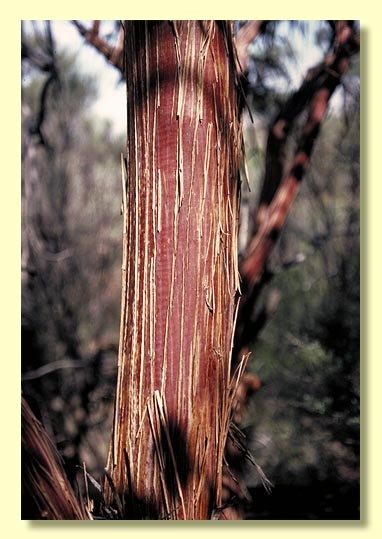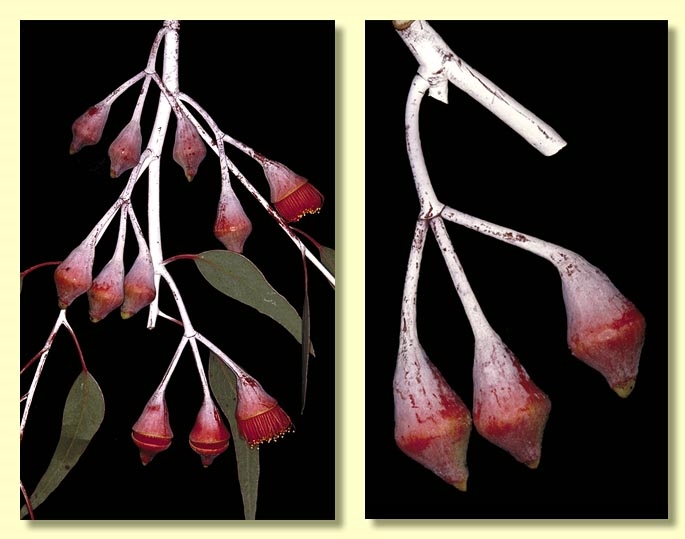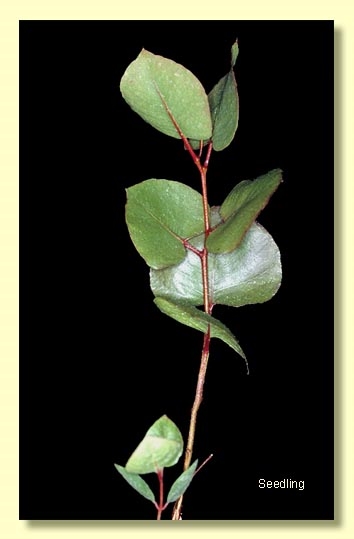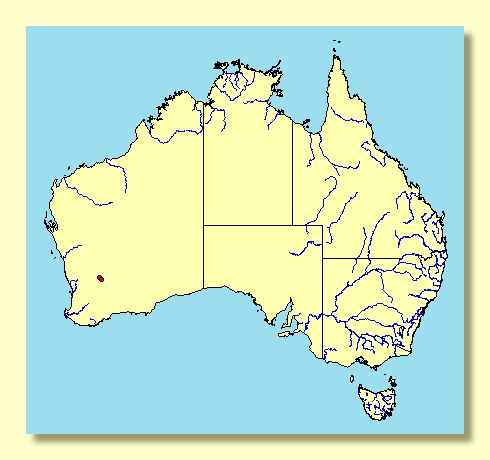Euclid - Online edition
Eucalyptus caesia subsp. magna
Eucalyptus | Symphyomyrtus | Bisectae | Destitutae | Caesiae
Bark minnirichi on trunk and branches, reddish-brown.
Branchlets glaucous over shining red; drooping; lacking oil glands in the pith.
Juvenile growth (coppice or field seedlings to 50 cm): stems rounded in cross-section; juvenile leaves always petiolate, opposite for 1 or 2 nodes then alternate, cordate, ca 6–10 cm long, 5.5–8 cm wide, glossy, green, thick.
Adult leaves alternate, petioles (2)3–6.2 cm long; blade lanceolate to falcate, 9–20(24) cm long, 2.2–4(5) cm wide, base tapering to petiole, margin entire, apex pointed, concolorous, dull, usually grey-green but sometimes green, thick, side-veins acute, reticulation dense to very dense, intramarginal vein very close to margin, oil glands intersectional.
Inflorescence axillary unbranched, pendulous, peduncles 2–6.5 cm long, buds 3 per umbel, pedicels 1.3–3 cm long. Mature buds pyriform to more or less diamond-shaped (2.1–3 cm long, 1.5 cm wide), glaucous and often finely striate, the outer operculum ceases to grow early in bud development and sheds in fragments leaving a scar on the young still growing buds, and this scar becomes obscured by further growth ultimately appearing as a rim well above where the inner operculum will separate from the hypanthium at flowering; inner operculum bluntly conical to beaked, stamens inflexed, anthers globoid, versatile, basifixed, dehiscing by longitudinal slits, style long and straight, stigma rounded to blunt, locules 5 or 6(7), the placentae each with 6(?8) vertical rows of ovules. Flowers with red-pink filaments and yellow anthers.
Fruit pedicellate (pedicels 2–3.2 cm long), barrel-shaped to slightly campanulate or rarely urceolate, 1.7–3 cm long, 2.3–2.8(3.7) cm wide, disc descending, valves 5 or 6(7), at about rim level or slightly enclosed.
Seeds blackish, 1.5–3 mm long, angular-ovoid to more or less cuboid, dorsal surface smooth or shallowly reticulate, hilum ventral or terminal.
Cultivated seedlings (measured at node 10): cotyledons Y-shaped (bisected); stems rounded in cross-section, smooth or slightly warty; leaves always petiolate, opposite for 5 to 8 nodes then alternate, broadly cordate to orbicular, 6–8 cm long, 5.5–7.5 cm wide, base lobed, green, glossy.
Flowering has been recorded in July and August.
E. caesia is a popular ornamental.
Eucalyptus caesia is a mallee species endemic to Western Australia, of scattered distribution in the central and eastern wheatbelt east and north-east of Perth, always associated with granite outcrops. It has minnirichi bark on trunks and branches, waxy branchlets and dull grey-green leaves.
It belongs in Eucalyptus subgenus Symphyomyrtus section Bisectae subsection Destitutae because buds have two opercula, cotyledons are Y-shaped and branchlets lack oil glands in the pith. Within this subsection E. caesia has no very close relatives being morphologically isolated from other species by the combination of large urceolate fruit with descending disc and valves never exserted, inflexed stamens, ovules in 6 rows, glossy green juvenile leaves in contrast to dull grey-green adult leaves, minnirichi bark and pink flowers, whilst the buds are amongst the most peculiar in the genus Eucalyptus. The buds have an unusual operculum construction which is described above.
There are two subspecies:
E. caesia subsp. caesia
Occurs nearer to Perth, e.g. Boyagin Rock, Mount Caroline, The Humps, an erect mallee with smaller leaves, buds and fruit than subsp. magna.
E. caesia subsp. magna
Differs by the pendulous habit such that many branches rest finally on the ground and with larger parts than subsp. caesia. It occurs further to the east, e.g. Chiddarcooping Hill and Chutawalakin Hill.
Both subspecies are commonly grown as ornamentals, with subsp. magna, notable for its larger flowers and heavily glaucous branchlets and fruits, being especially popular. Plants are often sold with the name "Silver Princess". It survives well in sheltered situations in heavily frosted areas like Canberra. It flowers in winter.
subsp. magna: Latin magnus, large, great, referring to the size of the buds and fruit in comparison with subsp. caesia.
















